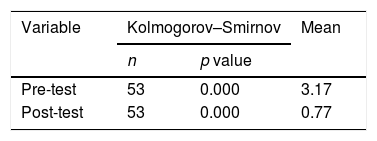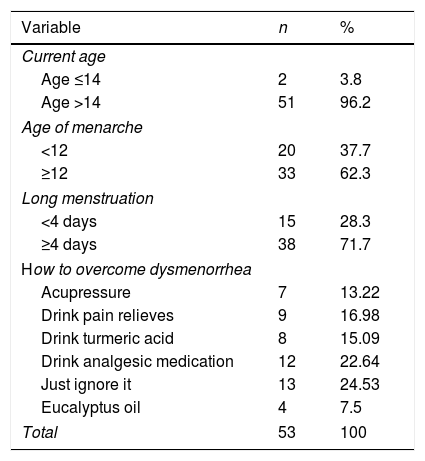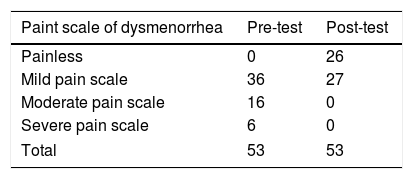According to survey conducted by researchers at SMAN 01 Tulang Bawang Tengah, it was found that 88.3% (53) female students from 60 students aged 16 to 18 had dysmenorrhea, which consisted of mild dysmenorrhea of 54.72%, moderate dysmenorrhea of 33.96%, and heavy dysmenorrhea is 11.32%.
PurposeDetermine the differences of before and after acupressure therapy on decreasing dysmenorrhea pain.
MethodsThe type of research used in this study is quantitative research using a quasi-experimental research design with one group pre-test and post-test approach. The study was conducted at SMAN 1 Tulang Bawang Tengah. The population in this study were all students of class X IPA as many as 60 students who experienced dysmenorrhea at SHS 1 Center Tulang Bawang. The size of the sample using the Slovin formula with the results of 52 female students. The selection of samples in this study was conducted by purposive sampling. The study used univariate and bivariate analysis with the Wilcoxon test.
ResultsThe results showed that most respondents were >14 years old, most of the respondents got menarche at age >12 years, most of respondents had menstrual period for >4 days and most respondent overcome pain dysmenorrhea without doing anything. Based on the analysis, the p value was 0.000.
ConclusionThere is a difference before and after the administration of acupressure therapy to treat pain in dysmenorrhea.
In general, student at senior high school entering adolescence. Adolescence is a stage between childhood and adulthood. This term indicates the period from the beginning of puberty until the maturity of the reproductive organs. Reproduction organs at puberty have begun to function. One of characteristics of puberty is menstruation.1 During menstruation, women are experiencing pain. This condition is called dysmenorrhea, which is a painful condition during menstruation which can cause mild cramps in the genitals until can disruption in daily tasks and can interfere with daily activities.2
Dysmenorrhea usually accompanied by cramps and concentrated in the lower abdomen. Menstrual pain complaints can occur ranging from mild to severe.3 The impact of dysmenorrhea can result in young women being forced to leave school learning activities and even sometimes can make someone helpless or faint, worry overload, stress, and others.2
Dysmenorrhea occurs because the endometrium in the phase of secretion produce excessive prostaglandin, prostaglandin (PGF-2 ALFA) which cause hypertonic and vasoconstriction in the myometrium, causing endometrial disintegration ischemia bleeding and pain.1 According to research, that has been done by Ridwan4 titled ‘the effect of acupressure in minimizing dysmenorrhea in adolescent girls’ by using sp 6 point, it was a decrease in the intensity of dysmenorrhea pain by 1.3 points after being given acupressure therapy.
Based on data in Indonesia it is estimated that 55% of women of women of childbearing age who are tortured by pain during menstruation, the incidence of primary dysmenorrhea in Indonesia in 2008 reached 54.89%, while the remaining 9.36% were secondary type suffers.5
Many types of treatment both pharmacological and non-pharmacological that have been researched to treat dysmenorrhea, pharmacological treatment that are often used by most women are NSAID's (Nonsteroidal Anti Inflamatori Drugs) groups such as mefenamic acid, ibuprofen, sodium diclofenac and naproxen.1 Nonpharmacological treatment can be done in various ways such as warm compresses, massage, physical exercise, and acupressure and acupuncture therapy.6
Acupressure comes from the word of accus and pressure, which means needle and press. This term is used the technique of pressing the finger at certain point instead of needle sticking on the acupuncture healing system. The function of the body's organs will be disrupted of it gets enough energy. Impaired bodily functions will disturb the balance of the body's systems.7
Acupressure points are the centers where our energy is collected. The emphasis on these points is intended to influence it so that the flow of energy that is likely to be blocked can be launched again. The smooth flow of energy affects the flow of blood, transportation of bodily fluids, nervous system, hormonal system, lymph system, etc.6
The pressure points used in the acupressure technique are the same points used in the acupressure technique. Several points that have been proven can be used for handling dysmenorrhea, including the Sanyinjiao point (SP6), hoku/hequ point (LI4), and ST36 point.6 Scientific research on the effects of acupressure therapy to overcome dysmenorrhea in adolescents is still limited. Some studies that have been done on adult women and are not focused on adolescent.6 The purpose of this study is to find a picture of the difference before and after the administration of acupressure therapy in the reduction of dysmenorrhea pain in 10th grade teenage girls in Tulang Bawang Tengah senior high school.8
MethodsThis type of research used in this research is quantitative research. This research is a quantitative study using a quasi-experimental research design. The design used in this study is one group pre-test and post-test. This research was conducted in Tulang Bawah Tengah senior high school. Research sampling in 10 sains young women class. This research was conducted at 17–31 January 2019. The population of this research is all of class 10 sains of 60 students who have dysmenorrhea who attended in SMAN 1 Tulang Bawang Tengah. According to observations made by the study, the size of the sample obtained using the Slovin9 formula is as follows:
Information
n = number of samples to be used for research
N = total population
e = margin error rate
n = 60/(1+(0.0025))=60/1.15=52.17=52 students.
Sample selection in this study was carried out by means of purposive sampling. Considerations made by researchers in the selection of samples are to determine the criteria consist of inclusion and exclusion criteria.
Inclusion criteria in this study sample are:
- a.
Respondents are class XI PA students and experience dysmenorrhea
- b.
No effect of analgesic drugs
- c.
Responses that experience dysmenorrhea are willing to be the subject of research
Exclusive criteria in this sample are:
- a.
Respondents who are not willing to be the subject of research.
- b.
Suffers from other diseases that cause dysmenorrhea.
The presentation of data and hypothesis testing depends on whether the data is normal or not. For hypothesis testing, if normal distribution uses parametric tests, if it is not normal it uses non-parametric tests. Normality test using Kolmogorov–Smirnov, which is the normality test in studies with the number of respondents or n≥50. Data are normally distributed when p>0.05 and said not normal if p<0.05.
Based on Table 1, the results are obtained p<0.05 means the data distribution is not normal. The results of the analysis with the Wilcoxon test obtained the p value results of <0.000, where p value 0.005 then Ha was accepted. So, it can be concluded that the differences before and after the administration of acupressure therapy in decreasing the pain of dysmenorrhea in adolescent.
The mean (average value of each variable) before therapy is 3.17 and after therapy is 0.77.
Univariate analysisRespondent characteristics based on age, age at menarche, menstrual length and how to cope with dysmenorrhea. Table 2 explains that most respondents are aged >14 year (96.2%). Most respondents aged >12 (62.3%) at the time of menarche. Most respondents (71.7%) menstruate >4 day and most respondents (24.53%) just let alone the pain felt during menstruation without special handling.
Respondents characteristics.
| Variable | n | % |
|---|---|---|
| Current age | ||
| Age ≤14 | 2 | 3.8 |
| Age >14 | 51 | 96.2 |
| Age of menarche | ||
| <12 | 20 | 37.7 |
| ≥12 | 33 | 62.3 |
| Long menstruation | ||
| <4 days | 15 | 28.3 |
| ≥4 days | 38 | 71.7 |
| How to overcome dysmenorrhea | ||
| Acupressure | 7 | 13.22 |
| Drink pain relieves | 9 | 16.98 |
| Drink turmeric acid | 8 | 15.09 |
| Drink analgesic medication | 12 | 22.64 |
| Just ignore it | 13 | 24.53 |
| Eucalyptus oil | 4 | 7.5 |
| Total | 53 | 100 |
Based on Table 3, it can be seen that the intensity of dysmenorrhea pain before acupressure at three points is a mild pain scale (36 respondents), moderate pain scale (16 respondents), severe pain scale (6 respondents) whereas the intensity of dysmenorrhea pain after acupressure at three points is painless scale (26 respondents), moderate pain scale (27 respondents) and severe scale pain (0 respondent).
DiscussionDistribution of respondent characteristicsBased on the characteristics of the pain of dysmenorrhea in adolescent, most teenagers aged >14 years old, this is in adolescent, most teenagers aged 14 years, this is in accordance with the theory that the highest prevalence of dysmenorrhea occur in adolescent aged 15–18 years old.10 Based on research of Julianti11 obtained results about the age of the world's dysmenorrhea age 16–18 years old. Viewing when the age characteristics on menarche, most respondents get menarche at age >12 years old of 33 respondents (62.3%) and the least amount of 20 respondents, menarche is the first menstruation with the advent of the adolescent. During the period of 10–59 years dysmenorrhea occur. The results of this study according to the research done Julianti11 that mostly get first menarche at age >12 years old and mostly experienced dysmenorrhea. This phenomenon may be caused by prostaglandin endorphin are released and circulated during exercise.4 Based on research conducted by researchers proved that the most common way to overcome dysmenorrhea cannot be overcome, because someone's pain threshold is different. In this case the researcher gave an acupressure intervention at the point LI4, ST36, SP6, in patients with dysmenorrhea complaints.12 Nerve tissue will provide stimulus to the endorphin system to release endorphin according to the needs of the body and is expected to reduce pain during menstruation.13
Pain intensity dysmenorrhea before and after acupressure therapy in the adolescent groupMenstrual pain is normal but can be excessive if it is influenced by physical and psychological factors such as stress, shock, constriction of blood vessels, chronic disease, lack of blood, decreased body condition, or the influence of prostaglandin hormones. This symptom does not endanger their health. Secondary menstrual pain usually appears later, i.e., if there is a disease that occurs later. The cause of those abnormalities or diseases such as uterine infection, cysts or polyps, tumor around the womb, or it could be due to permanent aberration. There is also what is called endometriosis, which is an abnormality in the lining of the uterine lining that spreads out of the uterus, so that when menstruation approaches, the lining of the uterine wall thickens and extreme pain will be felt. Other than that, endometriosis can also disturb fertility. In this case dysmenorrhea can be caused by stress, and psychological disorder. With all three points can overcome.12
Differences before and after the administration of acupressure in adolescents’ groupsPain can be overcome by using pharmacological agents and pharmacology used as pain management. Usually for pain relief analgesics are used, which are divided into two groups namely non-narcotic analgesics and narcotic analgesics, the choice of drug depends on pain. However, drug use often causes side effects and sometimes the drug does not have the expected strength of effect14 whereas for non-pharmacological management which is often given include distraction, skin stimulation, relaxation, biofeedback, and acupressure. Acupressure is the development of acupuncture techniques. If the application of acupuncture must use a needle then by only using finger movements and presses that are the type of rotary press, press point and press straight acupressure can be done.15
Acupressure can open the blocks or narrowing in the vein blood vessel, stimulate nodes and the centricity and affect glandular functions, increase the level of nitric oxide (NO) so that it can relax the uterine muscles and inhibit excess, increase relaxation and reduce the pressure of smooth muscle contraction, due to changes brain chemistry, the degree of serotonin is reduced and works to increase the body's endomorphic secretion and can increase the degree of Neuropeptide Y.16 The condition can finally overcome finally can overcome the menstrual pain of women with dysmenorrhea, stimulate the nerve location in both muscles and other tissues so that it encourages the release of endorphins neurohormonal factors that lead to changes in pain processes in the brain and spinal stem, reduce the level of inflammation by increasing the smoothness of blood vessels and the release of immunomodulatory factors.17
Conflict of interestsThe authors declare no conflict of interest.
Peer-review under responsibility of the scientific committee of the 3rd International Conference on Healthcare and Allied Sciences (2019). Full-text and the content of it is under responsibility of authors of the article.










